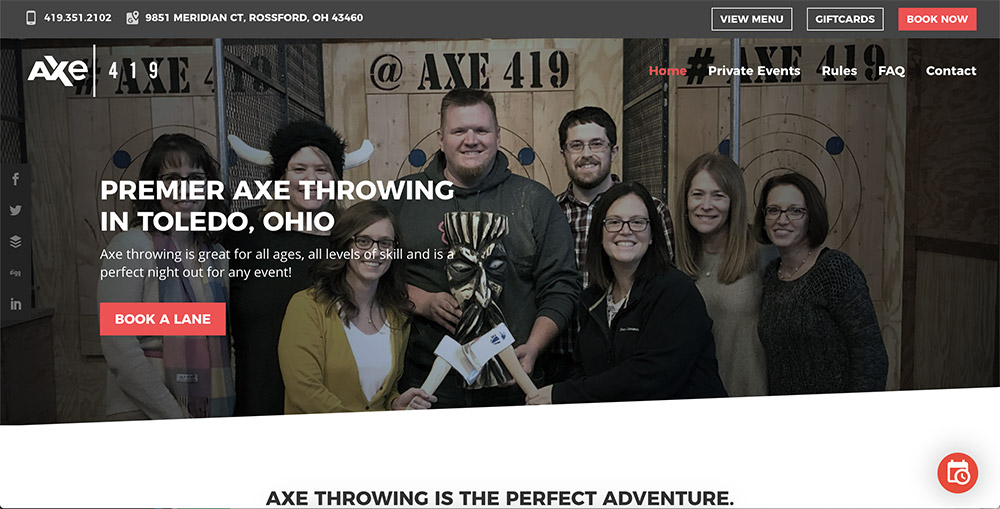One of the most popular topics for website owners is how to increase website traffic and for good reason. Your website isn’t worth much if it’s not getting any traffic.
Traffic is important, for sure. However, that’s only the first part of the equation. A lesser talked about topic is traffic conversion – essentially, the visitors come to your website, now what?
What do you want them to do once they’re there?
A million monthly visitors to your website is great but it means nothing if you’re not converting any of them into warm leads or customers.
Today I want to share with you 3 proven changes you can make to your website that will help to improve your website visitor conversion rate and create more warm leads and customers for your brand.
1. Provide a clear path
The first tip is often one of the most overlooked. Make sure your call-to-action elements aren’t tucked away somewhere down the page and don’t only link to your “book now” or “contact us” pages in your navigation menus.
If the main goal of your website is to get bookings or requests for quotes, there should be no less than 2-3 links to those pages on every page.
I’m not exaggerating. Make it clear.
You should place those links in obvious buttons somewhere in the header, somewhere in the main body of the page and again near the footer.

On the website axe419.com shown above, all 3 of the bright red elements are links to the booking form. There are other references further down the page but 2 obvious links persist on every page of the website:
- the red “Book Now” button in the header
- the red floating booking circle in the lower right that follows you down the page as you scroll
No matter where you are on any page of this website, there is a link you can click on to take you to the booking form.
This is important because not everyone is going to be ready to buy or book the first time they visit the site or right when the page loads so they’re likely going to scroll past the red booking button in the hero section at the top of the page. The only website visitors likely to click that button are those who are there with the intention of booking a lane.
For the other website visitors who might need a little convincing before they convert into customers, we have the other persissant elements.
2. Reduce the number of fields on your forms
Generally speaking, the fewer number of fields a form has introduces fewer objections from the user.
For example, if you ask for information the user may not comfortable giving out before you’ve built a better relationship with them, they may abandon the form altogether.
In a study conducted by MarketingExperiments, the website Marketo reduced the number of fields on its signup form and saw their form conversions increase.

It’s important to note, however, this is a fine line to walk and not always the case.
A good rule of thumb is to decide what the minimum amount of information is you need from a user to adequately process their request and start there.
Make it as easy as a possible for your potential customers to connect with you and then collect any additional information you’d like later, once you’ve formed that bond of trust with the customer.
3. Use the same words and phrases as your customer
This tip is extremely powerful. As brands and businesses, we’re extremely passionate and close to whatever field or industry we’re in. It’s easy for us to end up on tangents using technical jargon and slang when describing our products or services (especially product features) but this can be a huge mistake.
Remember that your customer is looking to hire someone who does what you do because they either can’t or won’t overcome the obstacle themselves. They likely don’t understand all of the technical terms.
A perfect example of this was Apple’s iPod. The iPod was certainly not the first portable mp3 player to hit the market and it was arguably not the best either. So why did it crush competing mp3 products sales numbers?
While the marketing for most mp3 players at the time focused on hard drive size and price in their market, Apple simply used the phrase “1000 Songs in Your Pocket.”
Most people at the time had no idea what a gigabyte was, let along how many songs could fit into one.
Apply used the words and phrases that the average person could easily understand and appreciate and left it at that.
Final Thoughts
Just to recap, if you’re looking to optimize your site to convert more of your website visitors, you need to make sure you have a few important elements in place to guide them along the way. Those elements are:
- a clear path you want them to take – make your call-to-action elements obvious and guide your users to the next step.
- reduce the number of fields in your contact forms – less fields = less friction and less opportunities for the visitor to say “no.” In the beginning try only collecting the information necessary to process the form submission and then collect the rest of the information later, once you have a foot in the door with your customer and you’ve begun building that trust.
- use the same words and phrases as your customer – listen for the words and phrases they’re using when you interact with them. Listen to the way they describe their problems and feelings. If you can flip it and use those same words and phrases in your marketing, you’ll have a much higher chance of your marketing resonating with them because the words will make sense to them.